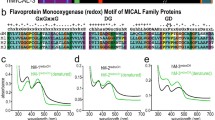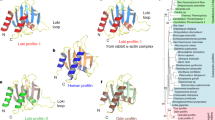Abstract
Diverse proteins that are 35% to 55% identical to actins have been discovered recently in yeasts, nematodes, and vertebrates. In order to study these proteins systematically and relate their functions to those of conventional actins, we are isolating the corresponding genes from the genetically tractable eukaryote,Drosophila melanogaster. Here we report the isolation and partial characterization of aDrosophila homologue of theSchizosaccharomyces pombe act2 gene. Degenerate oligonucleotide primers specifying peptides that are highly conserved within the actin protein superfamily were used in conjunction with polymerase chain reaction (PCR) to amplify a portion of theDrosophila gene that we have namedactr66B. The corresponding full-length cDNA sequence encodes a protein of 418 residues that is 65% identical to the product of theS. pombe act2 gene, 80% identical to the bovineact2 homologue, but only 48% identical to the principalDrosophila cytoplasmic actin encoded by theAct5C actin gene. Alignment of the yeast, bovine, andDrosophila actin-related proteins shows that they have four peptide insertions, relative to conventional actins, three of which are well placed to modify actin polymerization and one that is likely to perturb the binding of myosin. Locations of two of the fiveactr66B introns are conserved betweenDrosophila and yeast genes, further attesting that they evolved from a common ancestor and are likely to encode proteins having similar functions. We demonstrate that theDrosophila gene is located on the left arm of chromosome 3, within subdivision 66B. Finally, we show by RNA blot-hybridization that the gene is expressed at low levels, relative to conventional nonmuscle actin, in all developmental stages. From these and other observations we infer that the actr66B protein is a minor component of all cells, perhaps serving to modify the polymerization, structure, and dynamic behavior of actin filaments.
Similar content being viewed by others
References
Adams, M. D.,et al. (1991). Complementary DNA sequencing: Expressed sequence tags and human genome project.Science 2521651.
Ben Amar, M. F., Pays, A., Tebabi, P., Dero, B., Seebeck, T., Steinert, M., and Pays, E. (1988). Structure and transcription of the actin gene ofTrypanosoma brucei.Mol. Cell. Biol. 82166.
Benton, W. D., and Davis, R. W. (1977). Screening lambda gt recombinant clones by hybridization to single plaquesin situ.Science 196 180.
Bork, P., Sander, C., and Valencia, A. (1992). An ATPase domain common to prokaryotic cell cycle proteins, sugar kinases, actin, and hsp70 heat shock proteins.Proc. Natl. Acad. Sci. USA 897290.
Bray, D. (1972). Cytoplasmic actin: A comparative study.Cold Spring Harbor Symp. Quant. Biol. 37567.
Clark, S. W., and Meyer, D. I. (1992). Centractin is an actin homologue associated with the centrosome.Nature 359246.
Cupples, C. G., and Pearlman, R. E. (1986). Isolation and characterization of the actin gene fromTetrahymena thermophila.Proc. Natl. Acad. Sci. USA 835160.
Devereux, J., Haeberli, P., and Smithies, O. (1984). A comprehensive set of sequence analysis proteins for the VAX.Nucleic Acids Res. 12387.
Flaherty, K. M., DeLuca-Flaherty, C., and McKay, D. B. (1990). Three-dimensional structure of the ATPase fragment of a 70K heat-shock cognate protein.Nature 346623.
Flaherty, K. M., McKay, D. B., Kabsch, W., and Holmes, K. C. (1991). Similarity of the three-dimensional structures of actin and the ATPase fragment of a 70-kDa heat shock cognate protein.Proc. Natl. Acad. Sci. USA 885041.
Fyrberg, E. A., Mahaffey, J. W., Bond, B. J., and Davidson, N. (1983). Transcripts of the sixDrosophila actin genes accumulate in a stage- and tissue-specific manner.Cell 33115.
Gall, J. G., and Pardue, M. L. (1971). Nucleic acid hybridization in cytological preparations.Methods Enzymol. 21470.
Garrels, J. I., and Gibson, W. (1976). Identification of multiple forms of actin.Cell 9793.
Goldstein, L. S. B., and Vale, R. D. (1992). New cytoskeletal liasons.Nature 359193.
Greslin, A. F., Loukin, S. H., Oka, Y., and Prescott, D. M. (1988). An analysis of the macronuclear actin genes of oxytricha.DNA 7529.
Gruenstein, E., and Rich, A. (1975). Non-identity of muscle and non-muscle actins.Biochem. Biophys. Res. Commun. 64472.
Hightower, R. C., and Meagher, R. B. (1986). The molecular evolution of actin.Genetics 114315.
Hime, G., and Saint, R. (1992). Zygotic expression of thepebble gene is required for cytokinesis during the postblastoderm mitoses ofDrosophila.Development 114165.
Holmes, K. C., Popp, D., Gebhard, W., and Kabsch, W. (1990). Atomic model of the actin filament.Nature 34744.
Kabsch, W., Mannherz, H. G., Suck, D., Pai, E. F., and Holmes, K. C. (1990). Atomic structure of the actin:DNase I complex.Nature 34737.
Karlik, C. C., Mahaffey, J. W., Coutu, M. D., and Fyrberg, E. A. (1984). Organization of contractile protein genes within the 88F subdivision of theD. melanogaster third chromosome.Cell 37469.
Lees-Miller, J. P., Henry, G., and Helfman, D. M. (1992a). Identification ofact2, an essential gene in the fission yeastSchizosaccharomyces pombe that encodes a protein related to actin.Proc. Natl. Acad. Sci. USA 8980.
Lees-Miller, J. P., Helfman, D. M., and Schroer, T. A. (1992b). A vertebrate actin-related protein is a component of a multisubunit complex involved in microtubule-based vesicle motility.Nature 359244.
Lehner, C. F. (1992). Thepebble gene is required for cytokinesis inDrosophila.J. Cell Sci. 1031021.
Maniatis, T., Hardison, R. D., Lacy, E., Lauer, J., O'Connell, C., Quon, D., Sim, G. K., and Efstradiatis, A. (1978). The isolation of structural genes from libraries of eukaryotic DNA.Cell 15687.
McCombie, W. R.,et al. (1992).Caenorhabditis elegans.Nature Genet. 1124.
Milligan, R. A., Whittaker, M., and Safer, D. (1990). Molecular structure of F-actin and location of surface binding sites.Nature 348217.
Poole, S., Kauvar, L. M., Drees, B., and Kornberg, T. (1985). Theengrailed locus ofDrosophila: Structural analysis of embryonic transcript.Cell 4037.
Sanger, F., Nicklen, S., and Coulson, A. R. (1977). DNA sequencing with chain-terminating inhibitors.Proc. Natl. Acad. Sci. USA 745463.
Schwob, E., and Martin, R. P. (1992). New yeast actin-like gene required late in the cell cycle.Nature 355179.
Spradling, A. C., and Mahowald, A. P. (1979). Identification and genetic localization of mRNAs from ovarian follicle cells ofDrosophila melanogaster.Cell 16589.
Tanaka, T.,et al. (1992). Molecular cloning of bovine actin-like protein, actin2.Biochem. Biophys. Res. Commun. 1871022.
Vandekerchhove, J., and Weber, K. (1978). Mammalian cytoplasmic actins are the product of at least two genes and differ in primary structure in at least 25 identified positions from skeletal muscle actins.Proc. Natl. Acad. Sci. USA 751106.
Waterston, R.,et al. (1992). A survey of expressed genes in Caenorhabditis elegans.Nature Genet. 1114.
Wensink, P. C., Finnegan, D. G., Donelson, J. E., and Hogness, D. S. (1974). A system for mapping sequences in the chromosomes ofDrosophila melanogaster.Cell 3315.
Author information
Authors and Affiliations
Additional information
Our work was supported by grants from the NIH and the Muscular Dystrophy Association to E.A.F.
Sequences described herein have been filed in the GenBank Database under Accession Number X71789.
Rights and permissions
About this article
Cite this article
Fyrberg, C., Fyrberg, E. ADrosophila homologue of theSchizosaccharomyces pombe act2 gene. Biochem Genet 31, 329–341 (1993). https://doi.org/10.1007/BF00553175
Received:
Revised:
Issue Date:
DOI: https://doi.org/10.1007/BF00553175




